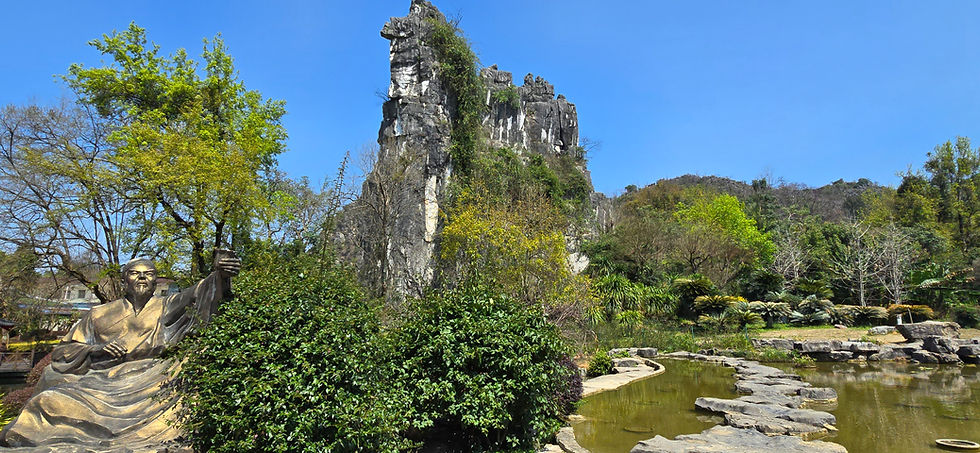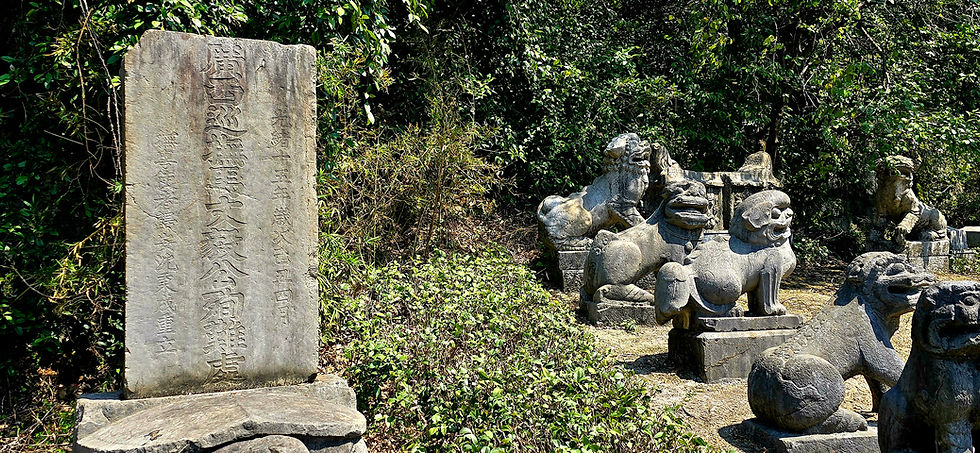Seven Star Park of the Immortals
- Shannon
- Jul 10
- 5 min read
Updated: Jul 11
Seven Star Park, located on the eastern side of Guilin, derives its name from the formation of seven limestone peaks arranged in the shape of the Big Dipper constellation. This celestial reference is not only a poetic nod to the stars but also deeply symbolic in Chinese cosmology, where the Big Dipper is associated with divine guidance, fate and protection. The park has been a cultural and spiritual haven for over 1000 years, revered by poets, monks and scholars alike. Carved into the natural karst landscape, the area has served as both inspiration and sanctuary across dynasties and more recently, as a place of refuge during the Japanese invasion of World War II. Today, memorials stand quietly among the trees, honouring those who perished while seeking shelter within its limestone embrace.

The centerpiece of the park is the famed Seven Star Cave, a vast subterranean cathedral of nature formed over millions of years. Within its shadowy halls, visitors can find ethereal formations of stalactites and stalagmites, some of which have been likened to dragons, lotus flowers and heavenly palaces. Historically, this cave has been a site of Buddhist devotion. Stone carvings and inscriptions, many dating back to the Tang and Song dynasties, are scattered across its chambers. These relics speak to the ancient belief that caves were gateways to the spiritual realm, places where the earthly and celestial meet. Local legend claims that monks once meditated deep within the cave to connect with otherworldly forces and gain prophetic visions.

The park’s Moon Gate is a perfect circle carved into a garden wall, a common feature in classical Chinese landscape design but here it carries a profound symbolic weight. Rooted in Taoist philosophy, the gate represents unity, eternity and the cyclical nature of existence. It is said that stepping through the Moon Gate allows one to shed worldly distractions and momentarily align with the rhythm of the cosmos. In folklore, it is even believed that those with an open heart may receive glimpses of past lives or ancestral wisdom while walking beneath its curve on a full moon night.

Elsewhere in the park stands Camel Hill, named for its uncanny resemblance to a resting camel and Crescent Mountain, whose gentle arch cradles the land like a sleeping moon. These natural features are more than scenic curiosities. According to local geomancers, they form part of a sacred Feng Shui alignment that draws vital "Qi" energy into the heart of the park. Elders still say that strange winds sometimes sweep through the trees during seasonal shifts, carrying whispers in an ancient dialect no longer spoken, believed by some to be the voices of forgotten ancestors.

Another historical treasure within Seven Star Park is the Guihai Stele Forest, a collection of inscribed stone tablets nestled between trees and mossy rocks. These stelae, some over a thousand years old, are etched with classical Chinese poetry, Confucian teachings and commemorative records. Scholars have long studied the site as a repository of calligraphic art and regional history. Yet, it also holds a more mysterious reputation. According to local superstition, those who trace the engraved characters during the ghost month (typically in the seventh lunar month) may invite the spirits of the original writers to linger nearby, especially if the person is carrying emotional burdens.

Of all the bridges crossing the park’s serene waterways, the Flower Bridge, dating back over 1100 years, remains the most photographed. It arches gracefully over the meeting point of the Xiaodong River and Lingjian Stream, a picturesque scene steeped in both beauty and legend. While it now stands as a symbol of classical romance and tranquility, the bridge harbours a more melancholic past. Local lore tells of a despondent scholar who, after failing the imperial examinations, threw himself into the river from this very spot. His restless spirit is said to linger still, pacing the bridge in the early morning mist, murmuring fragments of unfinished verse. Some visitors claim to have heard soft whispers or glimpsed a faint, cloaked figure vanishing into the dawn fog.
Once blessed by immortals, macaques are revered as symbols of luck, intelligence and divine companionship
Dark legends aside, the park is also a place of harmony, where the intersection of natural beauty, ancient belief systems and cultural memory creates a rare atmosphere. Taoist and Buddhist ideas weave through every corner, from mountain to cave, gate to stele, reminding visitors of the transience of life and the presence of the divine in all things. The very layout of the park follows principles meant to foster balance between man and nature, body and spirit.

As dusk falls and shadows stretch long across the limestone peaks, Seven Star Park takes on an almost otherworldly stillness. It’s easy to see why some believe the land is touched by celestial forces, its quiet grandeur holds a sense of timelessness. Whether you come seeking history, beauty or mystery, the park offers more than what first meets the eye. It's a layered landscape where legend and reality coalesce under the watchful gaze of the stars.

Location : Qixing Park Rear Gate - 1 Qixing Road, Guilin, Qixing District, Guilin, Guangxi, China
How to get there : Seven Star Park is centrally located on the east bank of the Li River, roughly 1.5 km's from Guilin’s city centre. The park is easily accessible by multiple public bus routes,on foot or via Didi Taxi. The park has multiple entrances, each located on a different road for convenient access. The Main Gate is on Ziyou Road, the Rear Gate is on Qixing Road, the North Gate is on Qixia Road, and the Guihai Stele Forest Gate is located on Longyin Road.
Attraction Info : The park is open daily, with seasonal hours from 6am to 7:30pm between March and November and 6am to 6:30pm from December to February. Admission to Seven Star Park costs ¥55, with additional fees for specific attractions such as the Seven Star Cave (¥45) and the Guilin Zoo (¥50). Combo tickets are available. Students with valid ID can receive a 50% discount and those enrolled in schools within Guilin may qualify for free entry. Prices are subject to change, so it’s best to check current rates before visiting. Directions to the cave are visible throughout the park. Guided tours are available for a small fee but they're mostly in Mandarin. Allow at least 3 hours to explore everything, as this park is massive. Access is relatively easy with minimal steps, except up Putuo Mountain (there are several hundred steep steps up to the peak). With multiple entry points, historical landmarks and scenic landscapes, Seven Star Park remains one of Guilin's most iconic attractions.
七星公园
Thanks for reading about Seven Star Park of the Immortals. Check out more destinations here!
These statues are not merely figures of worship, they are venerable sentinels, each guarding an aspect of life: compassion, protection and enlightenment

The view of downtown Guilin from Putuo Peak






































